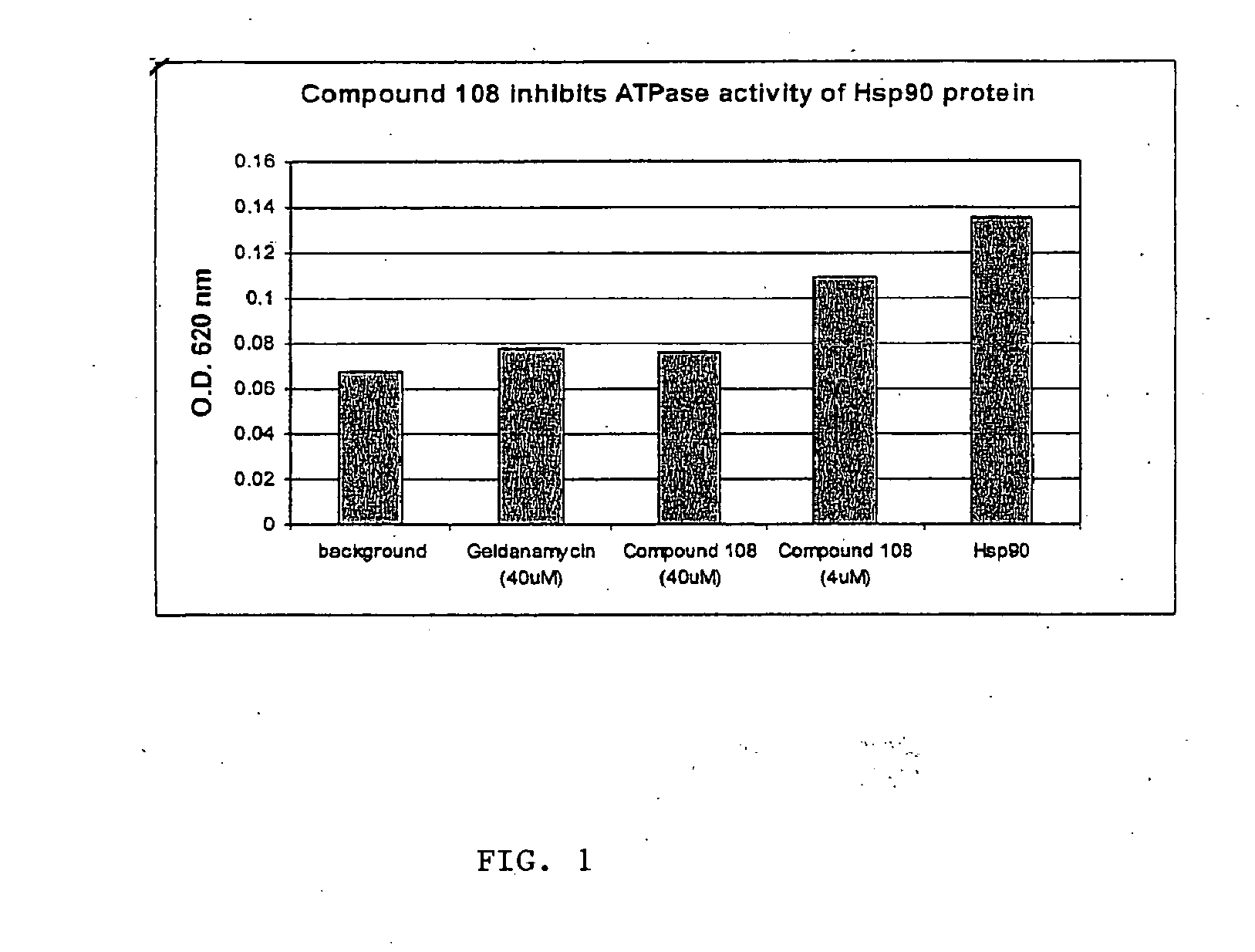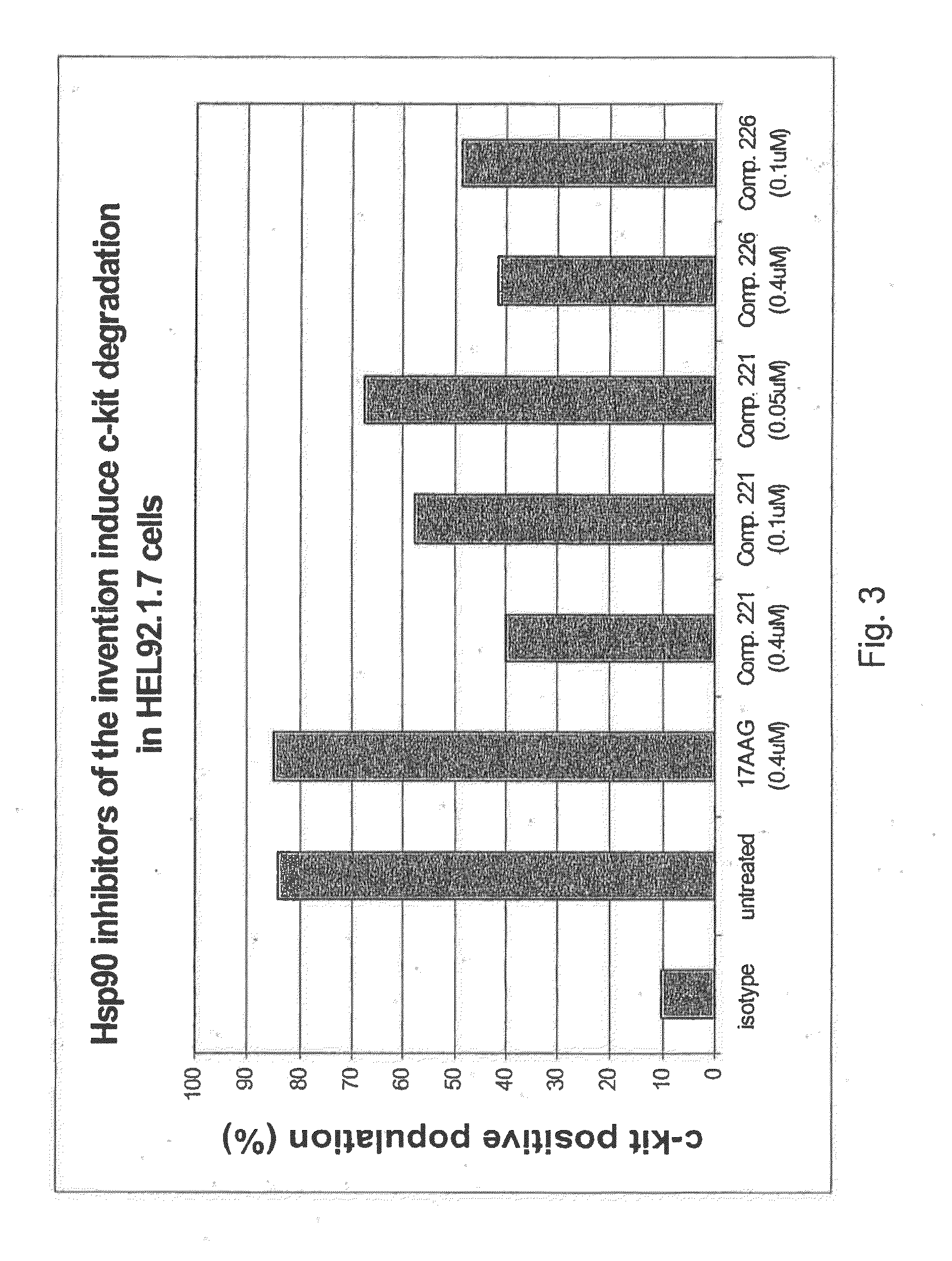Compounds that modulate hsp90 activity and methods for identifying same
a technology of hsp90 activity and compounds, applied in the field of compounds that modulate hsp90 activity and methods for identifying same, can solve the problems of unsatisfactory current chemotherapy, dismal prognosis for the majority of patients diagnosed with cancer, and the inability to fully implement a therapeutic agent that acts on one molecular target, and achieve the effect of reducing the growth rate of mda-mb-435s cells
- Summary
- Abstract
- Description
- Claims
- Application Information
AI Technical Summary
Benefits of technology
Problems solved by technology
Method used
Image
Examples
example 1
Inhibition of Hsp90
[0729]Hsp90 protein was obtained from Stressgen (Cat#SPP-770). Assay buffer: 100 mM Tris-HCl, Ph7.4, 20 mM KCl, 6 mM MgCl2. Malachite green (0.0812% w / v) (M9636) and polyviny alcohol USP (2.32% w / v) (P1097) were obtained from Sigma. A Malachite Green Assay (see Methods Mol Med, 2003, 85:149 for method details) was used for examination of ATPase activity of Hsp90 protein. Briefly, Hsp90 protein in assay buffer (100 mM Tris-HCl, Ph7.4, 20 mM KCl, 6 mM MgCl2) was mixed with ATP alone (negative control) or in the presence of Geldanamycin (a positive control) or Compound 108 in a 96-well plate. Malachite green reagent was added to the reaction. The mixtures were incubated at 37° C. for 4 hours and sodium citrate buffer (34% w / v sodium citrate) was added to the reaction. The plate was read by an ELISA reader with an absorbance at 620 nm.
[0730]As can be seen in FIG. 1, 40 μM of geldanamycin, a natural product known to inhibit Hsp90 activity, the ATPase activity of Hsp90 ...
example 2
Degradation of Hsp90 Client Proteins Via Inhibition of Hsp90 Activity
[0731]A. Cells and Cell Culture
[0732]Human high-Her2 breast carcinoma BT474 (HTB-20), SK-BR-3 (HTB-30) and MCF-7 breast carcinoma (HTB-22) from American Type Culture Collection, VA, USA were grown in Dulbecco's modified Eagle's medium with 4 mM L-glutamine and antibiotics (100 IU / ml penicillin and 100 ug / ml streptomycine; GibcoBRL). To obtain exponential cell growth, cells were trypsinized, counted and seeded at a cell density of 0.5×106 cells / ml regularly, every 3 days. All experiments were performed on day 1 after cell passage.
[0733]B. Degradation of Her2 in Cells after Treatment with a Compound of the Invention
[0734]BT-474 cells were treated with 0.5 μM, 2 μM, or 5 μM of 17AAG (a positive control) or 0.5 μM, 2 μM, or 5 μM of Compound 108 or Compound 49 overnight in DMEM medium. After treatment, each cytoplasmic sample was prepared from 1×106 cells by incubation of cell lysis buffer (#9803, cell Signaling Technol...
example 3
Compound 49 Displays Anti-Tumor Activity Against the Human Tumor Cell Line MDA-MB-435S in a Nude Mouse Xenograft Model
[0746]The human tumor cell line, MDA-MB-4355 (ATCC #HTB-129; G. Ellison, et al., Mol. Pathol. 55:294-299, 2002), was obtained from the American Type Culture Collection (Manassus, Va., USA). The cell line was cultured in growth media prepared from 50% Dulbecco's Modified Eagle Medium (high glucose), 50% RPMI Media 1640, 10% fetal bovine serum (FBS), 1% 100× L-glutamine, 1% 100× Penicillin-Streptomycin, 1% 100× sodium pyruvate and 1% 100×MEM non-essential amino acids. FBS was obtained from Sigma-Aldrich Corp. (St. Louis, Mo., USA), and all other reagents were obtained from Invitrogen Corp. (Carlsbad, Calif., USA). Approximately 4-5×10(6) cells that had been cryopreserved in liquid nitrogen were rapidly thawed at 37° C. and transferred to a 175 cm2 tissue culture flask containing 50 ml of growth media and then incubated at 37° C. in a 5% CO2 incubator. The growth media ...
PUM
| Property | Measurement | Unit |
|---|---|---|
| weight percent | aaaaa | aaaaa |
| weight percent | aaaaa | aaaaa |
| weight percent | aaaaa | aaaaa |
Abstract
Description
Claims
Application Information
 Login to View More
Login to View More - R&D
- Intellectual Property
- Life Sciences
- Materials
- Tech Scout
- Unparalleled Data Quality
- Higher Quality Content
- 60% Fewer Hallucinations
Browse by: Latest US Patents, China's latest patents, Technical Efficacy Thesaurus, Application Domain, Technology Topic, Popular Technical Reports.
© 2025 PatSnap. All rights reserved.Legal|Privacy policy|Modern Slavery Act Transparency Statement|Sitemap|About US| Contact US: help@patsnap.com



